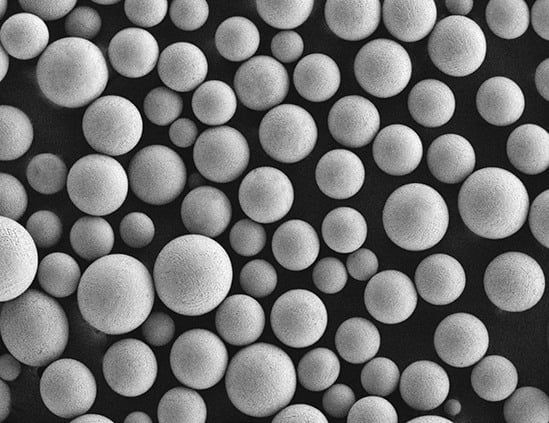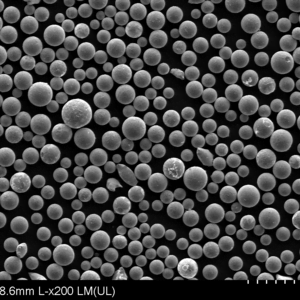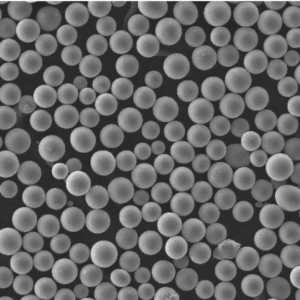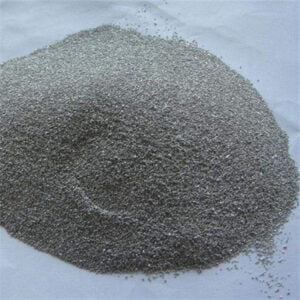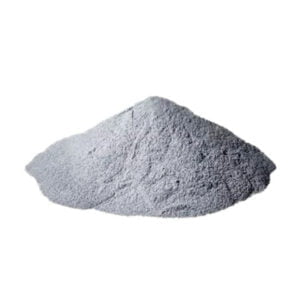Ti3Al-pulver
Ti3Al-pulver, även känt som titanaluminidpulver, är en intermetallisk förening tillverkad av titan och aluminium. Den har väckt stort intresse på senare år tack vare sina exceptionella egenskaper vid höga temperaturer och sin låga vikt jämfört med andra titanlegeringar.
Ti3Al-pulver kan produceras genom olika metoder, inklusive gasatomisering, mekanisk legering och termisk plasmasfäroidisering. Det finns i olika partikelstorlekar, morfologier och renhetsgrader för att passa olika applikationer. De viktigaste användningsområdena för Ti3Al-pulver är inom flyg-, fordons-, biomedicinsk och kemisk processindustri.
Låg MOQ
Tillhandahålla låg minsta orderkvantitet för att möta olika behov.
OEM & ODM
Tillhandahålla kundanpassade produkter och designtjänster för att tillgodose unika kundbehov.
Tillräckligt lager
Säkerställa snabb orderhantering och tillhandahålla tillförlitlig och effektiv service.
Kundtillfredsställelse
Tillhandahålla högkvalitativa produkter med kundnöjdhet i fokus.
dela denna produkt
Innehållsförteckning
Ti3Al-pulver: Sammansättning, egenskaper, användningsområden och mycket mer
Några av de viktigaste egenskaperna och kännetecknen för Ti3Al-pulver inkluderar:
- Hög hållfasthet vid förhöjda temperaturer upp till 750°C
- Densitet ungefär hälften så hög som för nickel-superlegeringar
- Enastående korrosionsbeständighet
- Låg densitet jämfört med andra titanlegeringar
- Oxidationsbeständighet upp till ca 700°C
- Slitstyrka
- Biokompatibilitet
Ti3Al har dock också begränsningar som dålig duktilitet vid rumstemperatur, låg brottseghet och dålig svetsbarhet. Korrekt bearbetning och legeringstillsatser krävs för att optimera balansen mellan egenskaper för olika applikationer.
Denna artikel ger en detaljerad översikt över sammansättning, egenskaper, användningsområden, leverantörer, kostnader, testmetoder och andra tekniska detaljer relaterade till Ti3Al-pulver.
Ti3Al pulversammansättning
Ti3Al-pulver har en nominell sammansättning av 75% titan och 25% aluminium efter vikt. Den intermetalliska föreningen titanaluminid bildar mellan 50-75% aluminium, med Ti3Al som den vanligaste versionen.
Den exakta sammansättningen kan variera beroende på produktionsmetod. Andra element som Nb, Mo, Si, B, Ta, W, C och O tillsätts ofta i små mängder för att förbättra vissa egenskaper. Tabellen nedan visar det typiska sammansättningsintervallet:
| Element | Vikt % |
|---|---|
| Titan (Ti) | 69 – 76% |
| Aluminium (Al) | 24 – 31% |
| Niob (Nb) | 0 – 6% |
| Molybden (Mo) | 0 – 4% |
| Kisel (Si) | 0 – 2% |
| Bor (B) | 0 – 0.5% |
| Tantal (Ta) | 0 – 5% |
| Volfram (W) | 0 – 5% |
| Kol (C) | 0 – 0.1% |
| Syre (O) | 0 – 0.2% |
Kontroll av syre- och kolinnehållet är avgörande för att undvika försprödning och bibehålla seghet. Andra spårämnen kan också förekomma beroende på råmaterial och process.
Egenskaper för Ti3Al-pulver
De unika egenskaperna hos Ti3Al-pulver härrör från dess ordnade intermetalliska kristallstruktur som består av både titan- och aluminiumatomer. Några av de anmärkningsvärda egenskaperna inkluderar:
Hållfasthet vid höga temperaturer
Ti3Al bibehåller en relativt hög hållfasthet upp till 750°C, betydligt bättre än titan eller enbart aluminium. Detta gör den lämplig för applikationer vid förhöjda temperaturer i motorer, turbiner, ventiler etc. I tabellen nedan jämförs Ti3Al:s hållfasthet med andra titanlegeringar vid olika temperaturer:
| Legering | Rumstemperatur Hållfasthet (MPa) | Hållfasthet vid 500°C (MPa) | Densitet (g/cm3) |
|---|---|---|---|
| Ti3Al | 400 | 260 | 3.9 |
| Ti6Al4V | 900 | 500 | 4.5 |
| Ti64 | 900 | 400 | 4.5 |
Låg densitet
Med en densitet på cirka 3,7 - 4,1 g/cm3 är Ti3Al mycket lättare än nickel-superlegeringar och de flesta andra titanlegeringar. Detta bidrar till att minska komponentvikten, vilket är kritiskt inom flyg- och rymdindustrin.
Oxideringsbeständighet
Ti3Al har god oxidationsbeständighet upp till 700°C i luft, bättre än olegerat titan. Detta gör att den kan användas vid höga temperaturer utan alltför stor materialförlust.
Motståndskraft mot korrosion
Titaninnehållet ger Ti3Al utmärkt korrosionsbeständighet mot ett brett spektrum av syror, alkalier och saltvattenmiljöer. Detta gör det användbart i utrustning för kemisk bearbetning.
Slitstyrka
Ti3Al har god nötnings- och erosionsbeständighet som är jämförbar med stål, vilket gör den lämplig för applikationer med högt slitage som ventiler, pumpar och extruderingsformar.
Ti3Al lider emellertid också av nackdelar som:
- Dålig duktilitet och brottseghet vid rumstemperatur
- Svårt att tillverka och bearbeta
- Dålig svetsbarhet på grund av känslighet för sprickbildning
Korrekt bearbetning och legeringstillsatser krävs för att optimera balansen mellan egenskaperna för den avsedda tillämpningen.
Ti3Al-pulver Tillämpningar
De unika egenskaperna hos Ti3Al-pulver gör det lämpligt för följande applikationer:
Flyg- och rymdindustrin
Flyg- och rymdindustrin är den största användaren av Ti3Al-produkter på grund av behovet av viktbesparingar, hög temperaturstyrka och oxidationsbeständighet. Typiska tillämpningar är bl.a:
- Turbinblad, skovlar, skivor
- Förbränningskammare, efterbrännare
- Flygplansskrov, strukturella komponenter
- Hydraulslangar, ventiler
Fordon
Bilindustrin använder Ti3Al för turbokomponenter, ventiler, fjädrar, fästelement och delar till avgassystem som kräver hög temperaturhållfasthet och lägre vikt.
Kemisk bearbetning
Ti3Al används för komponenter som ventiler, pumpar, rördelar och reaktionskärl som kräver korrosionsbeständighet i kombination med mekaniska egenskaper vid höga temperaturer.
Biomedicinsk
Ti3Al:s biokompatibilitet, korrosionsbeständighet och styrka gör det lämpligt för ortopediska implantat som konstgjorda höftleder.
Andra användningsområden är högpresterande ventiler, extruderingsverktyg, värmeelement och sportartiklar. Ti3Al används också som pulver för additiv tillverkning.
Specifikationer för Ti3Al-pulver
Ti3Al-pulver finns i olika storleksintervall, morfologier och renhetsgrader beroende på produktionsprocessen. De viktigaste specifikationerna anges nedan:
| Specifikation | Detaljer |
|---|---|
| Partikelstorlekar | 15 - 150 mikrometer |
| Morfologi | Sfärisk, vinklad, blandad |
| Skenbar densitet | 2 - 3,5 g/cm3 |
| Tappdensitet | 3 - 4,5 g/cm3 |
| Renhet | ≥99%, ≥99.9% |
| Syrehalt | ≤ 0,2 wt% |
| Kväveinnehåll | ≤ 0,05 wt% |
| Kolinnehåll | ≤ 0,08 wt% |
| Järninnehåll | ≤ 0,30 wt% |
| Nickelinnehåll | ≤ 0,10 wt% |
| Standardförpackningar | 5 kg, 10 kg, 25 kg |
Finare partikelstorlekar ger i allmänhet bättre flytbarhet, packningstäthet och reaktivitet. Sfäriska morfologier förbättrar också pulverflödet. Högre renhet minskar mängden föroreningar och förbättrar egenskaperna.
Produktion av Ti3Al-pulver
Det finns flera metoder som används för att producera Ti3Al-pulver inklusive:
- Atomisering av gas - Smält Ti-Al-legering finfördelas med inert gas till fina droppar som stelnar till pulver. Detta ger sfäriska partiklar med god flytbarhet.
- Mekanisk legering - Elementära Ti- och Al-pulver kulfräses för att syntetisera den intermetalliska föreningen mekaniskt. Pulverpartiklarna har oregelbundna former.
- Sfäroidisering av plasma - Oregelbundet Ti3Al-pulver från mekanisk legering smälts om i en plasma för att generera sfäriskt pulver.
- Induktionssmältning med elektrod och gasatomisering (EIGA) - Smält och finfördela en elektrod av Ti3Al direkt för att producera pulver.
Gasatomisering och plasmabehandling ger bättre kontroll över partikelstorleksfördelning, morfologi, syreupptagning och mikrostruktur. Pulvret måste vanligtvis siktas i specifika storleksfraktioner efter produktion baserat på applikationskrav.
Kostnad Ti3Al-pulver
Ti3Al-pulver är betydligt dyrare än enbart titan- eller aluminiumpulver. Kostnaderna varierar mellan:
- $100 - $500 per kg för 99% gasatomiserat pulver med hög renhet
- $50 - $250 per kg för 99% mekaniskt legerat pulver
- $300 - $1000 per kg för 99,9% plasma sfäroidiserat pulver
Priserna beror på partikelstorlek, morfologi, renhetsgrad, orderkvantitet och tillverkare. Kundanpassade legeringar med speciella sammansättningar kan kosta ännu mer. Kostnaderna har sjunkit tack vare ökade produktionsvolymer och processförbättringar.
Ti3Al pulver leverantörer
Några av de största globala leverantörerna av Ti3Al-pulver inkluderar:
| Företag | Plats |
|---|---|
| AP&C | Kanada |
| TLS Teknik GmbH | Tyskland |
| Metallteknik | STORBRITANNIEN |
| ATI Pulvermetall | USA |
| Snickare Tillsats | USA |
| Met3DP | Kina |
| Tekna | Kanada |
Det finns även ett fåtal tillverkare i Kina. Vi rekommenderar att man köper pulver från etablerade tillverkare som använder kvalificerade produktionsprocesser för att säkerställa tillförlitlig kvalitet och egenskaper.
Ti3Al jämfört med alternativ
Ti3Al konkurrerar med flera alternativ för strukturella tillämpningar vid höga temperaturer:
Tabell: Jämförelse mellan Ti3Al och andra högtemperaturlegeringar
| Legering | Täthet | Max temperatur | Styrka | Duktilitet | Oxideringsbeständighet | Kostnad |
|---|---|---|---|---|---|---|
| Ti3Al | Låg | Mycket hög | Hög | Låg | Bra | Hög |
| Inconel 718 | Hög | Hög | Medium | Medium | Bra | Medium |
| Haynes 230 | Hög | Mycket hög | Hög | Låg | Utmärkt | Mycket hög |
| Ti6Al4V | Medium | Medium | Medium | Medium | Utmärkt | Medium |
| Ferritiska rostfria stål | Medium | Medium | Låg | Hög | Dålig | Låg |
För maximala driftstemperaturer är Ti3Al och nickelbaserade superlegeringar som Haynes 230 överlägsna. Den lägre densiteten och kostnaden för Ti3Al är dock fördelaktig för viktkritiska applikationer som t.ex. flyg- och rymdindustrin.
Den dåliga duktiliteten hos Ti3Al vid rumstemperatur är fortfarande en viktig begränsning jämfört med stål och Ti6Al4V. Legerings- och processutvecklingen fortsätter att förbättra bearbetbarheten och tillverkningsbarheten.
Fördelar med Ti3Al-pulver
Viktiga fördelar med att använda Ti3Al-pulver är bl.a:
- Hög hållfasthet bibehållen till 800°C
- Densitet 40% lägre än nickel-superlegeringar
- Utmärkt krypmotstånd
- God oxidations- och korrosionsbeständighet
- Ersättning av eldfast metall utan strategiska materialrisker
- Tillverkning av nära nätform med pulvermetallurgi
- Komponenterna kan arbeta vid högre temperaturer
- Viktbesparingar i roterande delar som turbinblad
- Förbättrad effektivitet genom högre driftsparametrar
Den unika balansen mellan mekaniska egenskaper, låg densitet och termisk stabilitet gör Ti3Al till ett material som möjliggör nästa generations flyg-, fordons- och kraftgenereringssystem.
Begränsningar för Ti3Al-pulver
Trots sina fördelar har Ti3Al också vissa nackdelar:
- Skör vid rumstemperatur, duktiliteten förbättras över 500°C
- Tillverkning och maskinbearbetning är utmanande
- Snabb förlust av egenskaper under 400°C
- Råvaru- och bearbetningskostnaderna är mycket höga
- Leveranskedjan är begränsad med få producenter
- Komponentdesign kräver specialiserad teknisk expertis
- Svårt att svetsa eller sammanfoga med konventionella tekniker
- Svårt att återvinna och återanvända
Tillverknings- och kostnadshinder har hittills bromsat en bred kommersiell användning av Ti3Al. Men dess egenskaper fortsätter att driva på utvecklingsarbetet för att övervinna dessa begränsningar genom förbättrade legeringskemier, pulverkvalitet och komponentdesign.
Utsikter för Ti3Al-pulver
Ti3Al förväntas få ökad användning inom flyg-, fordons-, industrigasturbin- och kraftproduktionssektorerna på grund av:
- Ökad efterfrågan på jetmotorers bränsleeffektivitet och lägre utsläpp
- Material för höga temperaturer krävs för elektriska turboladdare
- Växande marknad för additiv tillverkningsteknik
- Fokus på strategisk materialsubstitution för sällsynta jordartsmetaller och eldfasta metaller
- Kostnadsminskning genom förbättrad produktivitet i tillverkningen
Bil- och industrimarknaderna är mer priskänsliga och kräver bevisade fördelar i fråga om kostnad och prestanda jämfört med befintliga legeringar. Flyg- och rymdsektorn är mer villig att betala en premie för maximal prestanda.
Statliga initiativ i USA, EU och Japan påskyndar FoU inom produktion av Ti3Al-pulver, komponenttillverkning, sammanfogningsmetoder och legeringsutveckling. Detta kommer att utöka användningsområdena och driva på en högre användningstakt.
Vanliga frågor och svar
F: Vad används Ti3Al-pulver till?
A: Ti3Al-pulver används för att tillverka högtemperaturkomponenter som turbinblad, turboladdningshjul, värmeväxlare och andra delar som arbetar i 500-800°C. Det ger en utmärkt balans mellan hög hållfasthet, låg densitet och god oxidationsbeständighet.
F: Hur tillverkas Ti3Al-pulver?
S: Vanliga produktionsmetoder är gasatomisering, plasmaatomisering, elektrodinduktionssmältande gasatomisering (EIGA) och mekanisk legering. Varje process resulterar i olika pulveregenskaper som lämpar sig för specifika applikationer.
F: Är Ti3Al-pulver bättre än Inconel 718?
A: Ti3Al har lägre densitet och ger därför viktbesparingar jämfört med Inconel 718. Det har högre hållfasthet vid temperaturer över 700°C. Duktiliteten hos Ti3Al vid rumstemperatur är dock ganska låg, medan Inconel 718 lätt kan tillverkas och bearbetas.
F: Vad är kostnaden för Ti3Al-pulver?
A: Ti3Al-pulver kostar cirka $450-750 per kg, vilket är nästan 5 gånger dyrare än nickel-superlegeringar och 10 gånger mer än titan- eller aluminiumpulver. Den höga kostnaden beror på komplex bearbetning och begränsad efterfrågan på marknaden.
F: Hur hanteras och förvaras Ti3Al-pulver?
A: Liksom andra reaktiva legeringspulver kräver Ti3Al inert gas och fuktfri förvaring. Endast behållare av keramik, glas eller rostfritt får användas. Säkerhetsåtgärderna omfattar jordning, ventilation och andningsskydd.
F: Vilka är utmaningarna med att använda Ti3Al-pulver?
S: De viktigaste begränsningarna är dålig duktilitet vid rumstemperatur, höga materialkostnader, begränsat antal leverantörer, svårigheter vid bearbetning/tillverkning och avsaknad av sammanfogningsteknik. För att öka den kommersiella användningen krävs legeringsförbättringar, processutveckling och optimering av komponentdesignen.
F: Vilka är framtidsutsikterna för Ti3Al-pulver?
S: Användningen av Ti3Al-pulver förväntas öka betydligt inom flygmotorer, turboladdare för bilar och industriella applikationer för höga temperaturer. Initiativ för att sänka kostnaderna, förbättra egenskaperna och mogna tillverkningen kommer att möjliggöra en bredare användning.
Få det senaste priset
Om Met3DP
Produktkategori
HOT SALE
KONTAKTA OSS
Har du några frågor? Skicka oss meddelande nu! Vi kommer att betjäna din begäran med ett helt team efter att ha fått ditt meddelande.

Metallpulver för 3D-printing och additiv tillverkning
FÖRETAG
PRODUKT
cONTACT INFO
- Qingdao City, Shandong, Kina
- [email protected]
- [email protected]
- +86 19116340731






